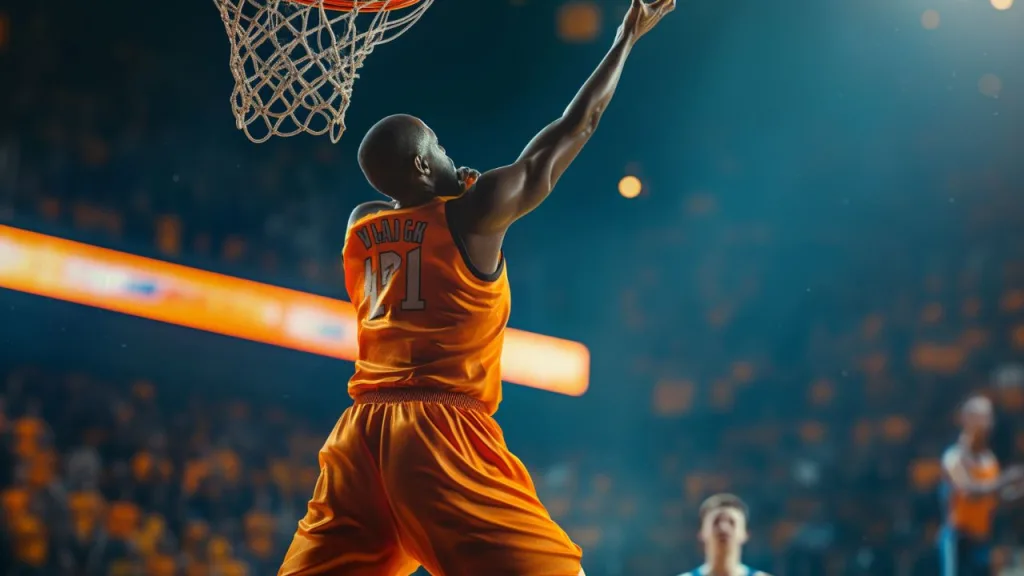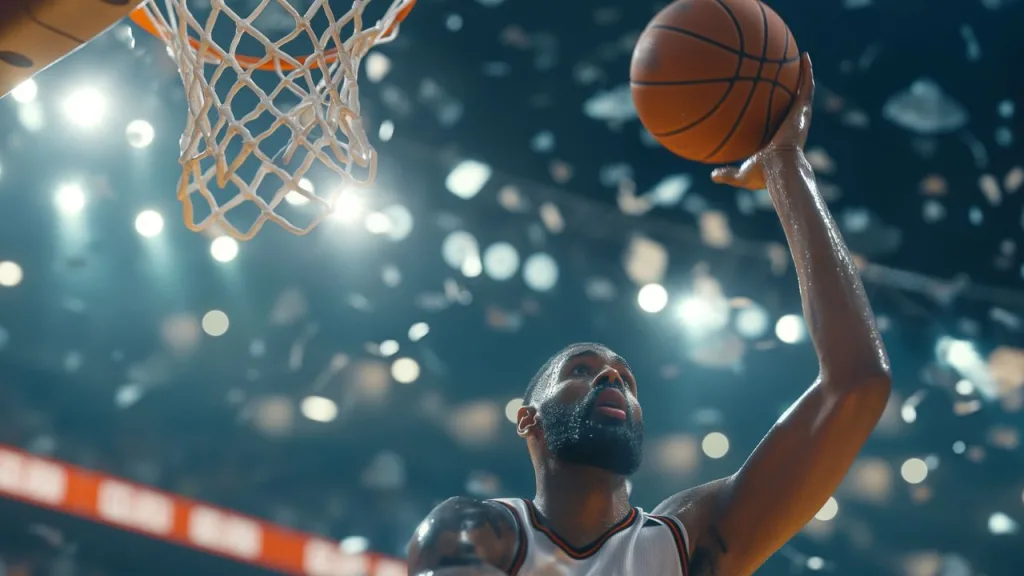Last Updated on: 5th March 2024, 06:35 pm

In basketball, players like Giannis Antetokounmpo stand out for their impressive wingspan, often outstretching opponents on the court. Whether a longer wingspan always leads to better performance remains a topic of debate.
The height provides a visible advantage, but the specific impact of the wingspan on a player’s game is not fully understood. Understanding how these physical attributes influence gameplay is a puzzle waiting to be solved.
Players with longer wingspans may have an advantage in blocking shots, stealing the ball, or reaching for rebounds. However, agility, skill, and basketball IQ significantly affect a player’s performance. Considering how these factors interact and contribute to a player’s success on the court is essential.
Significance of Wingspan & Height
Measurements taken at the NBA Draft Combine offer valuable insights for evaluating prospects and forecasting their success in the league. Understanding the correlation between wingspan and height provides a window into basketball prospects’ defensive capabilities and overall potential.
Wingspan vs. Height: The Debate
The comparison between height and wingspan in basketball sparks discussions on player performance and strategic advantages on the court.
NBA players with longer wingspans like Giannis Antetokounmpo and Kawhi Leonard excel in defensive coverage because they can block shots and disrupt passing lanes effectively.
On the other hand, players with shorter wingspans might showcase better shooting accuracy and control, enhancing their offensive capabilities. The debate surrounding wingspan versus height revolves around finding the most important balance between defensive prowess and shooting ability.
Coaches and scouts analyze these physical attributes to determine how they can impact a player’s overall performance on the court. Understanding the importance of wingspan in basketball is essential for maximizing a player’s potential and effectiveness in different aspects of the game.
The Role of Wingspan

What is Wingspan?
When measuring fingertip to fingertip, the wingspan plays a significant role in basketball performance. Here are some key points about wingspan:
- Wingspan is the distance from one fingertip to another when arms are outstretched.
- Players can have wingspans longer or shorter than their height.
- NBA Draft Combine uses wingspan to evaluate players.
- Players like Mo Bamba and Talen Horton-Tucker have notable wingspan differences.
- Longer wingspans offer advantages in defense and shot-blocking.
Wingspan’s Defensive Benefits
Having a long wingspan in basketball can greatly benefit your defensive game. Blocking shots, rebounding, stealing, and disrupting plays are all areas where your wingspan plays an important role.
Your extended reach can make scoring challenging for opponents and create opportunities for your team.
Blocking Shots
With a longer wingspan, basketball players gain a significant advantage in blocking shots effectively near the basket.
- Extended Reach: Long arms help reach higher and cover more area.
- Shot-Blocking Prowess: Players like Mo Bamba and Anthony Davis excel in shot-blocking.
- Disrupting Opponents: Wingspan disrupts shots and alters shooting angles.
- Defensive Stops: Longer wingspans lead to more defensive stops and turnovers.
- Rim Protection: The height and wingspan combination protects the rim effectively.
Rebounding
Players with longer wingspans gain a defensive advantage in rebounding due to their extended reach and ability to contest shots effectively. With wingspans exceeding their height by several inches without shoes, these players can outstretch opponents, making it challenging for the offensive player to score or secure rebounds.
This defensive prowess contributes markedly to a team’s ability to limit second-chance points per game, showcasing the impact of players’ wingspan on defensive plays.
Stealing
Longer wingspans in basketball players offer a defensive advantage in stealing by increasing their reach and disrupting opponents’ plays effectively.
- Long wingspans help in reaching further for steals.
- Easier ball swiping and pass interception.
- Players like Kawhi Leonard excel in stealing due to long wingspans.
- Anticipation and quick reactions improve with longer wingspans.
- Teams prefer players with long wingspans for their defensive abilities.
Disrupting Plays
How does wingspan impact defensive plays in basketball?
Players with longer wingspans disrupt plays by extending their reach, affecting passing lanes and shooting attempts.
Defenders with greater wingspans can contest shots without fouling, altering opponents’ shooting accuracy.
Shot-blocking prowess, exemplified by players like Rudy Gobert, stems from extended wingspans.
This disruptive ability extends to steals, as longer arms aid in intercepting passes and creating turnovers for fast breaks.
Wingspan’s Impact by the Numbers
With wingspan as a key metric in basketball analysis, its impact on player performance becomes evident through defensive reach and strategic advantages on the court. Players with longer wingspans tend to have a greater defensive reach, disrupting passing lanes effectively. Long wingspans allow players to defend closer to the basket without sacrificing mobility, enhancing their defensive capabilities.
Elite defenders like Giannis Antetokounmpo and Kawhi Leonard excel in the NBA due to their long wingspans, providing them with a defensive edge. NBA teams prioritize players with long wingspans to improve their defensive prowess and minimize physical mismatches on the court. Wingspan plays an important role in basketball by influencing defensive abilities and creating advantages for players in various game situations.
The Role of Height

Height is important in basketball, impacting your reach on the court and your effectiveness in different positions. Taller players often excel in rebounding, shot-blocking, and scoring near the basket due to their height advantage.
Understanding how height influences defensive capabilities and overall statistical performance is essential for success in basketball.
Understanding Height
In basketball, a player’s height determines their effectiveness on the court.
- Height Impact: Taller players have advantages in rebounding, shot-blocking, and shooting over defenders.
- Position Determination: Height often dictates a player’s position, with taller players typically filling center or power-forward roles.
- Rim Protection: Centers and power forwards with exceptional height contribute considerably to rim protection and interior scoring.
- Draft Stock Influence: NBA teams prioritize taller players for their potential impact in the paint and defensive abilities.
- Defensive Presence: Height influences players’ defensive capabilities, affecting their ability to contest shots and alter opponents’ attempts.
Height’s Defensive Benefits
Height plays a pivotal role in your defensive game. It allows you to contest shots effectively, defend the post with authority, and dominate the boards by grabbing rebounds.
With your height advantage, you can disrupt opponents’ offensive plays, protect the rim, and create defensive mismatches on the court.
Utilize your height to significantly impact defense, from challenging shots to securing crucial rebounds for your team.
Contesting Shots
Defenders with longer wingspans in basketball can greatly impact their ability to contest shots effectively and disrupt opponents’ shooting angles.
- Extended reach to challenge shots
- Disruption of shooting angles
- Ability to alter or block shots without fouling
- Enhanced defensive capabilities against jump shots and layups
- Increased value for coaches and scouts in deterring scoring opportunities
Defending the Post
For guarding the post effectively, having a taller stature provides inherent advantages in shot contesting and defensive presence. Taller players protect the rim, block shots, and deter opponents from scoring near the basket.
Height disrupts opponents’ shots, forcing adjustments in shooting angles and release points, leading to lower shooting percentages. Tall defenders intimidate offensive players, limiting high-percentage shots in the paint.
Rebounding
When rebounding in basketball, having a longer wingspan gives players a significant advantage in securing missed shots.
- Longer wingspans aid in grabbing rebounds over opponents.
- Height assists in boxing out and contesting rebounds effectively.
- Taller defenders can alter shots and limit offensive rebounds.
- Extended reach from wingspan leads to second-chance opportunities on offense.
- Taller players dominate the boards, combining height and wingspan in rebounding.
Height’s Statistical Influence
Height greatly impacts your ability to excel in various aspects of basketball, such as contesting shots, rebounding, and scoring near the basket. Taller players have an advantage in blocking shots and altering opponents’ shooting angles. Your height influences your reach, allowing you to effectively play above the rim and secure rebounds.
In positions like center and power forward, your height becomes important to dominate inside the paint and protect the rim. Your defensive presence, scoring efficiency, and overall impact on the court are greatly influenced by your height. Embrace your height as a valuable asset that can enhance your performance and contribute to your success on the basketball court.
Finding the Balance
To understand the synergy of wingspan and height in basketball, you must consider how different combinations benefit players in various positions on the court. Finding the ideal balance between wingspan and height can enhance your performance in defense, rebounding, and shooting mechanics.
Moreover, remember that agility and jumping are vital beyond just wingspan and height in determining your overall effectiveness on the basketball court.
Synergy of Wingspan & Height
Optimizing the balance between wingspan and height in basketball can greatly enhance a player’s defensive prowess. When considering the synergy of wingspan and height, finding the right mix to excel defensively is essential. Here are some key points to keep in mind:
- Longer wingspans relative to height increase reach for shot-blocking and defensive disruptions.
- Balancing wingspan and height boosts defensive versatility while maintaining agility and offensive skills.
- Extended wingspans compensate for shorter height, improving defensive presence and shot-contesting abilities.
- Understanding the synergy between wingspan and height is crucial for maximizing defensive impact.
- Finding the ideal combination of wingspan and height can elevate your defensive performance on the basketball court.
Ideal Combinations by Position
Discovering the right mix of wingspan and height can greatly enhance your performance in basketball, especially when considering different player positions. For shot-blocking and rebounding, centers like Mo Bamba and Anthony Davis showcase vital wingspan-to-height ratios.
Forwards such as Jerami Grant and Kelly Oubre Jr. demonstrate essential wingspans that aid in defense and scoring.
Guards like Talen Horton-Tucker and Donovan Mitchell possess wingspans that enhance their defensive capabilities and playmaking skills.
Finding the right wingspan-to-height ratio is essential for players in different positions to excel in various aspects of the game. The balance between wingspan and height is vital for players to maximize their potential on both court ends.
Beyond Wingspan & Height: Agility and Jump
Moving beyond wingspan and height in basketball, consider the importance of agility and jumping ability to enhance your overall performance on the court. Agility allows you to move swiftly and change direction efficiently during gameplay.
Jumping ability is important for grabbing rebounds, blocking shots, and scoring near the basket. Finding the right balance between wingspan, height, agility, and jumping skills can optimize your performance on both offense and defense.
While longer wingspans can offer advantages in contesting shots and passing, agility and jumping skills are equally essential. Developing a diverse skill set that includes agility, jumping, wingspan, and height can make you a more versatile and effective player in various game scenarios.
Conclusion
To sum up, remember that in basketball, ‘good things come in small packages.’
While height and wingspan play vital roles in player performance, finding the right balance between the two is important.
Players can maximize their potential on the court by understanding how these physical attributes intersect.
Keep working on your skills, and remember that success in basketball isn’t just about how tall or long your arms are, but how you use them to your advantage.
